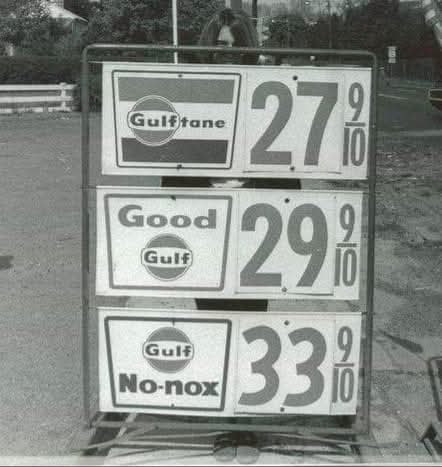
ADVERTISEMENT
A Nostalgic Journey: Gas Prices and the Golden Era of Road Trips
Introduction
The sight of a vintage gas price sign, such as the one in the image, evokes memories of a bygone era when road trips were simpler, cars were classic, and gas was astonishingly cheap. At just 27.9 cents per gallon for Gulftane and 33.9 cents for Gulf No-Nox premium fuel, this snapshot reflects a time when fuel costs were a fraction of what they are today. In this article, we’ll explore the historical context of these prices, the cultural significance of cheap gas, and why such imagery continues to inspire nostalgia and fascination.
The Era of Cheap Gasoline
The mid-20th century was a period of economic growth and cultural transformation in the United States. Gas prices in the 1950s and 1960s averaged around 30 cents per gallon, largely due to abundant domestic oil production and minimal inflation. This affordability made car ownership accessible to the average American family, transforming the automobile into more than just a mode of transportation—it became a symbol of freedom and mobility.
Fuel brands like Gulf, prominently featured in the image, competed fiercely to attract customers. They offered various grades of gasoline, such as Gulftane, Good Gulf, and Gulf No-Nox, to suit different customer preferences and vehicle needs. These options reflected the increasing demand for both affordability and performance in a rapidly modernizing automotive world.
Cultural Significance of Affordable Fuel
Cheap gas played a pivotal role in shaping mid-century American culture. The rise of suburban living, sprawling interstate highways, and the popularity of road trips were all fueled—literally—by the availability of inexpensive gasoline. Families would pile into their cars, hit the open road, and explore iconic destinations like Route 66, national parks, and coastal highways.
ADVERTISEMENT
Gas stations became more than just refueling stops. They were integral to the journey, offering services like oil changes, maps, and even food. The Gulf brand, in particular, was known for its innovative marketing, including promotional maps and the promise of “clean, friendly service.”
The prices on the sign in the image remind us of an era when the cost of fuel was an afterthought, leaving families free to focus on the joy of the journey rather than its financial burden.
A Window Into the Past
The gas price sign in the image is not just a relic of the past; it’s a time capsule. The decimal fractions, such as “9/10,” reflect a pricing strategy that persists today. This marketing technique was used to make prices appear lower, a practice that started in the early 20th century and remains a common feature at gas stations worldwide.
The inclusion of different gasoline grades—each with its own price point—also highlights the advancements in engine technology and the increasing consumer awareness of performance and fuel quality. Premium fuels like Gulf No-Nox were marketed as cleaner-burning and better for engines, appealing to drivers who wanted to maximize their car’s performance.
Why This Image Resonates Today
In an era of fluctuating gas prices and growing concerns about sustainability, images like this spark a sense of nostalgia for a simpler time. They remind us of an age when the open road symbolized freedom, and fuel was inexpensive enough to make spontaneous adventures possible.
ADVERTISEMENT
For many, this image also evokes memories of classic cars, roadside diners, and the thrill of exploring uncharted territory. It serves as a reminder of how far we’ve come in terms of automotive technology and environmental awareness, yet it also underscores the enduring allure of the road trip as a quintessential American experience.
Conclusion
The vintage gas price sign is more than just a record of past costs—it’s a symbol of an era defined by exploration, innovation, and freedom. It captures the essence of a time when gasoline was affordable, road trips were a cultural phenomenon, and the automobile reigned supreme as a gateway to adventure.
While today’s world looks vastly different, the nostalgia evoked by such images reminds us of the enduring romance of the open road. Whether it’s the thrill of discovery or the joy of simpler times, this snapshot of the past invites us to reflect on the role of fuel in shaping our history and culture.
Title: A Nostalgic Journey: Gas Prices and the Golden Era of Road Trips
ADVERTISEMENT




